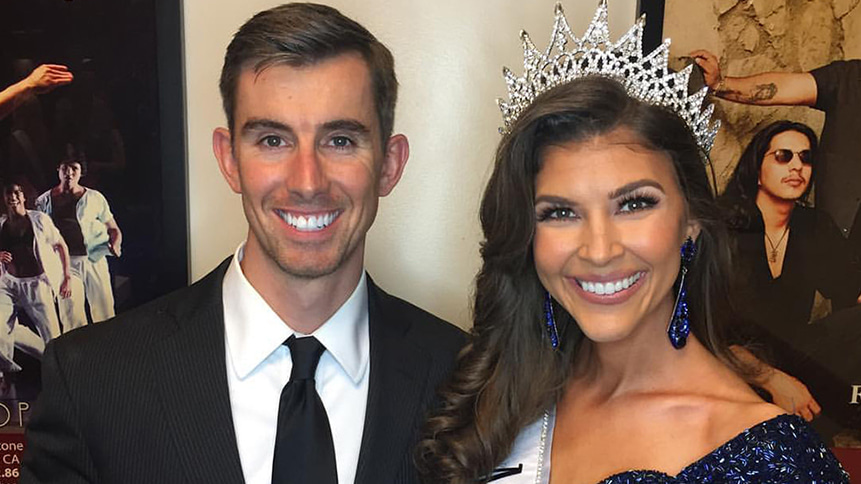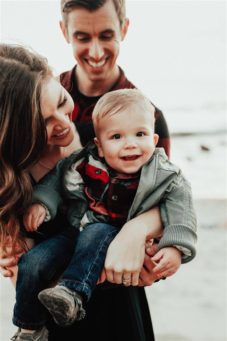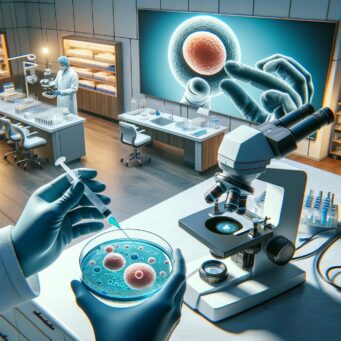
Heather Denison, Mrs. California 2014, decided to use her pageant platform to raise awareness about infertility – a disease that both she and her husband never expected to have when they decided to have a baby in their late 20s/early 30s.
Heather now runs the Meet the Hopefuls blog and advocates for infertility awareness and coverage by telling her story and sharing the stories of so many Americans who are affected by it.
We met Heather at Resolve’s Advocacy Day 2018 in Washington D.C., where Heather spoke with California lawmakers on behalf of the community.
Here’s more on why she’s passionate about advocating for infertility rights and elevating this conversation:
What’s your fertility story, in a nutshell?
As an elementary school teacher, I always knew I wanted kids, but we weren’t in a hurry to start our family. Chris is a stuntman, so we enjoyed our time as a couple traveling for his work. We were married for six years prior to trying, so we used to get a lot of inquiries about our desire to have kids. I remember one day I was talking with my childhood best friend, who also happens to be a birth doula. She was asking me about our prevention methods. I told her the “pull-out” method had been working for us like a charm. She seemed pretty shocked and told me if that’s really all we were doing, we may have some fertility issues. It’s humbling to admit now that I was in complete denial.
I was just under thirty when we actively started trying. Month after month I’d get my period and I started to have the sinking realization that my friend might be right. We booked an appointment with a reproductive endocrinologist, and I quickly learned I had polycystic ovarian syndrome (PCOS). The doc told us a round or two of Clomid would likely be a quick fix for us but, just to be safe, they ran tests on my husband, too. On Chris’s thirtieth birthday, we got a lifechanging phone call: His sample had zero sperm. Initially, we thought that this might be due to massive prior testicular trauma (remember, I married a stuntman!); but after further testing, and a physical exam, we found out Chris had a condition called congenital bilateral absence of the vas deferens (CBAVD) and he was a carrier for cystic fibrosis. I tested negative for the CF carrier gene, so we were cleared to start IVF treatment.
I met countless people at appearances and events during my year as Mrs. California who were struggling to start their families, or who struggled to have their child.Before my egg retrieval, Chris was scheduled for a MESA (micro epididymal sperm aspiration) procedure. The urologist quickly discovered Chris didn’t have sperm in the epididymal tissue to aspirate, so he made a game-time decision to try a TESE (testicular epididymal sperm extraction). This is where a small section of testicular tissue is removed and explored for sperm. We were extremely disheartened to learn after hours and hours of searching, the embryologist only found six barely wriggling sperm in Chris’s sample. The urologist and RE were both stumped, as his hormonal levels were perfect. They used the sperm they had and fertilized my eggs via ICSI. After five days, we had one fair quality embryo to freeze. A month later, we transferred the embryo and were so hopeful we’d have success. Two weeks later, we were devastated to learn my hCG levels indicated we were experiencing a chemical pregnancy.
Our reproductive endocrinologist was ready to give up on Chris’s sperm, and urged us toward a donor. Although our odds looked pretty slim, the urologist said he wanted to try three months of Clomid in conjunction with male fertility supplements to help Chris’s body create more healthy sperm. That three-month wait felt like an eternity, as there was no way to easily check his numbers to see if they were improving–although, Chris will tell you that he felt like “The Hulk” while on these supplements. We then also decided to switch RE’s and get a fresh perspective. Our new RE identified PCOS as a more prominent factor hindering our success and improved my stimming protocol. This gave us many more healthy, mature eggs to work with. After Chris’s TESE post-Clomid and supplements, we were thrilled to learn his count had drastically improved. We were able to get four PGS-tested embryos from that round.
Prior to our diagnoses there was zero appearance or evidence we had fertility issues. Everything appears to work normally on both of our ends. It wasn’t until we saw a specialist that we knew we had fertility problems.We transferred our top-quality embryo, and a couple weeks later were so thrilled to learn I was pregnant. A few weeks later, I started bleeding. I spoke with the nurse from our fertility clinic, and it was clear she didn’t think the prognosis was positive. They had me come in for an ultrasound and were having a hard time finding anything on the monitors. I took a deep breath and prepared for the worst, but suddenly our RE said, “Oh, there he is! Your son is a ninja! He was hiding on the ultrasound!”
We were incredibly relieved, but our minds were flooded with fears when we learned I had another fertility issue that had not yet been diagnosed until this point—I had adenomyosis. This condition affects implantation and can also cause miscarriages. I was put on bedrest for the majority of my first trimester. For most of my pregnancy with our son I was pretty guarded and anxious. His birth experience was quite traumatic, and we didn’t breathe easily until he was successfully in our arms. We are so incredibly thankful to have our son. His presence in our lives is not something we will ever take for granted.
Last fall, we attempted another cycle to have a second child, and give our son a sibling. Even though it was a PGS-tested embryo, we were unsuccessful. For the time being, we’ve decided to take a break from fertility treatments and are now more open to other avenues for building our family.
How has your experience as Mrs. California contributed to you sharing your story (or withholding it)?
In pageantry, most contestants have a “platform” which is an issue or cause they promote throughout their year. When I decided to compete for Mrs. California, it was the moment we took our infertility journey public. Initially, it was pretty terrifying to open up about our journey, but Chris and I felt strongly about the decision. Throughout our experience with infertility we felt incredibly alone. We didn’t know anyone else going through treatment or struggling. We wanted to make sure other couples didn’t feel that way.

Prior to competing in the pageant, contestants were encouraged to make a video to introduce ourselves and speak about our platforms. The day I shared the video on my Facebook page I was so anxious. Much to my surprise, several people reached out to me privately and told me they were struggling with fertility issues themselves. These were people I looked up to and admired and now they were cheering me on for having the courage to share our story! I realized in that moment this choice of platform was so important—so many people hide their fertility struggles because they feel intense shame. It was difficult for us to take the step into sharing our journey, but I’m so glad we did!
I was so thrilled that the judges for Mrs. California saw the value in our story and my platform and gave me the opportunity of a lifetime to raise awareness for infertility. I met countless people at appearances and events during my year as Mrs. California who were struggling to start their families, or who struggled to have their child. Their stories had a profound impact on me. That year changed me in a way I never even imagined. The desire to be a voice for this community was like a huge fire that was lit in the belly of my soul. Even though my year as Mrs. California has come to an end, this cause will forever remain close to my heart. I know my husband and I will continue to speak openly about our journey and advocate for the infertility community.
Why did you start your blog, Meet the Hopefuls?
When we started our blog, we were a completely closeted infertile couple. Even once we started IVF, my closest friends and family had no idea we were going through the process. I needed an outlet to air my feelings, fears, and frustrations, and honestly just to journal and keep track of the process. The act of blogging was so cathartic for me. I found connections with complete strangers who were on the same emotional roller coaster we were on. These are people I’m still in touch with to this day, and I’ve even had the privilege of meeting some of them face-to-face at RESOLVE’s Advocacy Day!
What’s surprised you most about your journey to parenthood?
The biggest surprise was infertility itself. Sex Ed teachers in the United States put the fear of God into students. They make us feel like pregnancy is way too easy to achieve. It makes it pretty surprising when you find out infertility is an issue that plagues you. To this same extent, when you’re young you look at raising a family as a given, something that you’ll just “do” when the timing is right. The sad fact is that there are few guarantees when it comes to fertility, other than the fact that if you end up going through multiple rounds of IVF, you are guaranteed to spend an insane amount of money!
What are some misconceptions you see about infertility that you hope to help clear up?
There are a three major misconceptions about infertility that both my husband and I frequently encounter:
1) Fertility treatments are guaranteed. Most people put a lot of faith in modern medicine, and as a result we tend to feel that fertility treatments are a sure thing. As all of us in this community know, this is just not the case. Even the best-case scenarios offer large margins of error, and most couples we know undergo multiple unsuccessful treatments before achieving a healthy pregnancy, and sadly some never do.
2) Infertility is a women’s health issue. Statistically speaking, 1/3 of issues are female, 1/3 are male, and 1/3 are either both or unexplained. We fall into this latter category: we both struggle with fertility issues, but our biggest challenges lie on the male side. However, if you asked the majority of well-meaning people, they’d tell you that this is a female-centric issue.
3) If you’re infertile, you’ll know. This one still surprises me, but often fertile people ask if we could tell my husband was “shooting blanks.” I get it, people are curious. The answer is no. Prior to our diagnoses there was zero appearance or evidence we had fertility issues. Everything appears to work normally on both of our ends. It wasn’t until we saw a specialist that we knew we had fertility problems. Many couples are completely blindsided by the diagnosis of infertility.
Why is being an advocate important, in your opinion, and how can people get involved?
If the issue of infertility touches your heart in some way on some level, please get involved. I’m not asking for you to blast your story all over social media, or tell everyone you know you’re struggling—although if you feel comfortable doing so, more power to you. What I mean is this: Volunteer. Start a support group. Answer calls on RESOLVE’s Helpline. Speak up with our lawmakers. And whatever you do, don’t feel ashamed—this is a common problem, and there are millions of people who have feel your same pain and are here to offer support, encouragement, and wisdom.
Also, one final thought: Infertility is underfunded. Infertile couples often have to pay for their treatments out of pocket. Chris and I have spent well over $50K trying to build our family. I know couples who have spent WAY more. This is insane. We deserve better treatment. Join us in our advocacy efforts. For more information on how to help the infertility community visit www.resolve.org/get-involved.

Listen to stories, share your own, and get feedback from the community.


















